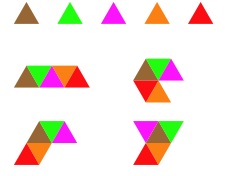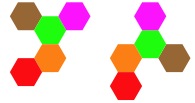Copyright © University of Cambridge. All rights reserved.
'Hexpentas' printed from https://nrich.maths.org/
Show menu
Why do this problem?
This activity is accessible to a wide variety of pupils. At one level, learners can explore ways of putting the five shapes together by 'playing' with hexagon pieces. At a higher level, more experienced or older pupils can be expected to go about the activity in an organised, systematic way. In addition, this
problem encourages learners to use visualisation, and to apply their understanding of reflective and rotational symmetry.
Possible approach
You may like to start by giving pupils the experience of this problem using five squares (pentominoes). Rather than asking them to make the different shapes, you could give them the set of twelve pentominoes and arrange them in different ways so that they are convinced there aren't any missing. This will help
them to develop a system for working on the hexagon version.
You could introduce the challenge by creating some hexagons to be dragged around the interactive whiteboard screen, or you could cut large shapes out of card and fix them to the board or wall. Encourage a few children to make their own arrangements for all to see so that everyone is clear about the task before giving time for pairs to investigate further. Children will find it useful to cut
out hexagons from this sheet (larger shapes) or perhaps to colour in arrangements on this sheet (smaller shapes).
You may need to have a mini-plenary at an appropriate moment to discuss shapes that may be reflections or rotations of each other. At this point, having the interactive whiteboard would be helpful so that you can demonstrate rotations or flips easily (although this can be done by cutting out shapes or joining hexagons together so they can be manipulated physically).
In the plenary, you could pool all the different shapes that the group has found. You could then either invite some pairs up to explain their own ways of working systematically, or you could ask the class to order the shapes that are displayed so that any missing ones can be identified.
Key questions
Are any of your shapes the same?
Have you done this in some way so that you know what you are going to try next?
How are you making sure you do not have the same one twice?
How are you recording these?
Possible extension
One possibility is for pupils to explore what happens with more hexagons. Alternatively, you could encourage them to ask "I wonder what would happen if I ...?" and to go down their own line of enquiry.
Possible support
An appropriate drawing program on the computer may be a useful tool for some pupils. Others will need to have hexagons to arrange.


